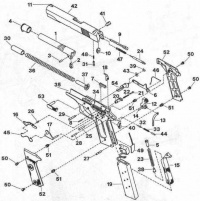How to safety check a 1911 after disassembly
From Gunsopedia
This article details the steps you need to take to insure the functional safety of your 1911 after each time you disassemble it. Following these simple steps will help you to avoid incidents like the negligent discharge described in the following anecdote:
Obviously, the individual in the above story violated one of the most basic rules of firearms safety, namely that you NEVER touch the trigger until you are ready to fire. That huge feat of negligence aside, however, he should have tested the weapon in an unloaded condition prior to firing it at all! This type of serious 1911 problem can be completely avoided when a few simple checks are performed:

My friend called me today and told me he witnessed an amazing negligent discharge (ND) at a shooting range in Las Vegas. A shooter was on the firing line with his 1911 and had just finished explaining to his friend that he was test firing it after installing a new grip safety. Evidently, he installed the “drop in” part by himself, and performed a bit of final fitting to it via a file, as it would not fit properly right out of the box. He loaded the weapon and set the thumb safety. He then fired a few rounds. No malfunctions occurred. After shooting 4 or 5 times, he again set the thumb safety and placed the pistol on the bench in front of him. He loaded some magazines and then picked up the pistol. As he was preparing to fire, his friend interrupted him and asked how it was working. He disengaged the thumb safety and transferred the weapon to his left hand, allowing it to sit flat in his palm. To demonstrate how well his new part worked, he pressed the trigger without gripping the weapon to engage the grip safety. BANG! He had a ND. Thankfully, no one was hurt and no property was damaged when the weapon fired. His $1,000 Kimber did, however, fly out of his hand and land on the concrete floor of the range. 
— The Firearm Resource, 7/31/09
- Make sure you have a safe area to perform these checks, to include a proper backstop, a clear downrange area, and eye and ear protection. Keep your weapon pointed in a safe direction at all times. Perform a chamber check and a magazine check to insure your weapon in unloaded.
- Cock the hammer and engage the thumb safety.
- Press the trigger while holding the weapon in a firing grip. The hammer should not fall.
- If the hammer does not fall, change your grip so that the grip safety is not depressed. The thumb safety should still be on. Again press the trigger. The hammer should not fall.
- If the hammer does not fall, disengage the thumb safety and repeat the trigger press while holding the weapon so the grip safety is not depressed. Again, the hammer should not fall.
- If the hammer does not fall, hold the weapon in a firing grip and press the trigger. The hammer should fall.
- If it seems to be working properly, repeat the function test a few times, cycling your action after each hammer fall (keep the trigger trapped to the rear). The trigger should crisply reset when you relax pressure against it when the slide is all the way forward, in battery.
If steps 3 through 7 produce any result other than the ones described above, you should have a gunsmith examine your pistol before you attempt to fire it again.
Even if you're a veteran 1911 armorer, perform these checks anyway. Anyone can make a mistake (yes, even you). Do not let a simple mistake injure or kill you or someone else.
